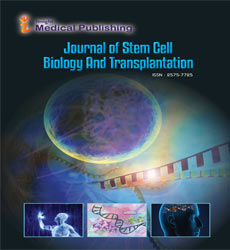ISSN : 2575-7725
Journal of Stem Cell Biology and Transplantation
Stem Cell Treatments May Reshape the Future of Medical Therapeutics
Khalid Ahmed Al-Anazi*
Consultant Hemato-Oncologist and Chairman, Department of Adult Hematology and Hematopoietic Stem Cell Transplantation, Oncology Center, King Fahad Specialist Hospital, P.O. Box: 15215, Dammam 31444, Saudi Arabia
- *Corresponding Author:
- Dr. Khalid Ahmed Al-Anazi
Consultant Hemato-Oncologist and Chairman
Department of Adult Hematology and Hematopoietic Stem Cell Transplantation
Oncology Center, King Fahad Specialist Hospital, P.O. Box: 15215
Dammam 31444, Saudi Arabia
Tel: 966 - 03- 8431111
Fax: 966- 03- 8427420
E-mail: kaa_alanazi@yahoo.com
Received Date: October 07, 2016; Accepted Date: October 13, 2016; Published Date: October 20, 2016
Citation: Al-Anazi KA. Stem Cell Treatments May Reshape the Future of Medical Therapeutics. Struct Chem Crystallogr Commun. J. Stem Cell Bio. Transplant. 2016, 1:1.
DOI: 10.21767/2575-7725.100001
Stem cells are biological cells that are capable of differentiation, division, renewal and tissue repair [1]. There are three types of stem cells: (1) totipotent; (2) multipotent such as mesenchymal stem cell (MSCs); and (3) pluripotent including embryonic stem cells (ESCs) and induced pluripotent stem cells (iPSCs) [1-5]. Stem cells can be derived from various sources including bone marrow, peripheral blood, umbilical cord, placenta, amniotic fluid, adipose tissue and dental pulp [1,2,6]. Each type of stem cells has its own distinguishing properties and flow cytometric findings [2,6].
The number of internationally registered clinical trials on MSCs has been increasing steadily since the year 2004 [7]. Their clinical applications include: (1) cardiovascular disorders such as coronary artery disease, myocardial infarction, dilated cardiomyopathy and critical limb ischemia; (2) type 1 diabetes mellitus; (3) autoimmune and collagen vascular disorders such as multiple sclerosis, systemic sclerosis, systemic lupus erythromatosis and Crohn's disease; (4) liver and spinal cord injuries, tissue repair, wound healing and regenerative medicine; (5) enhancement of engraftment as well as prevention and treatment of graft versus host disease in recipients of hematopoietic stem cell transplantation; and (6) sepsis, acute respiratory distress syndrome and various infections including multidrug resistant tuberculosis, viral hepatitis, Chagas disease and human immunodeficiency virus [5,6,8,9].
The use of iPSCs can avoid the obstacles and ethical issues that limit the use of ESCs [2,4]. Induction and programming of these stem cells employ DNA as well as non-DNA methods and require the presence of several factors including: species such as humans or mice; factors or chemicals such as proteins, genes or valproic acid; vectors such as lentivirus or retrovirus; cell type such as fibroblasts or blood cells and diseases with specific genetic mutations [2,4]. Their clinical applications include: (1) hemoglobinopathies such as β-thalassemia and sickle cell disease; (2) hereditary bone marrow failure syndromes such as Fanconi anemia and dyskeratosis congenita; (3) hemophilia A; (4) chronic myeloproliferative neoplasms such as myelofibrosis and polycythemia rubra vera; (5) synthesis of blood components; (6) disease modeling; (7) tissue engineering and regenerative medicine; (8) screening for drug toxicity, drug development and discovery; (9) metabolic disorders such as Hurler syndrome, Lysch-Nyhan syndrome and Wilson disease; and (10) various neurological and psychiatric disorders including Parkinson's disease, Alzheimer's disease, amyotrophic lateral sclerosis, Duchenne muscular dystrophy, Huntington's disease and schizophrenia [1,2,4,9].
MSCs & iPSCs may reshape the future of medical therapeutics and may eventually become curative for several chronic and intractable diseases [1,2,4-6,8,9]. However, the field is still in its infancy and plenty of research and clinical trials are needed to refine their future role [4,7]. Their complications particularly predisposition to cancer should not be underestimated. Also, the remaining challenges facing their clinical utilization need to be resolved [2,3]. Banking of stem cells is vital in order to make them readily available for clinical use [2]. Strict guidelines, standardization of techniques and quality control measures are essential for collection, culture, cryopreservation as well as clinical utilization of various types of stem cells [3,4,6,9].
References
- Hima Bindu A, Srilatha B (2011) Potency of various types of stem cells and their transplantation. J Stem Cell Res Ther: 1: 115
- Al-Anazi KA (2015) Induced pluripotent stem cell and their future therapeutic applications in hematology. J Stem Cell Res Ther. 5: 258.
- Sng J, Lufkin T (2012) Emerging stem cell therapies: treatment, safety, and biology. Stem Cells Int.
- Singh VK, Kalsan M, Kumar N, Saini A, Chandra R (2015) Induced pluripotent stem cells: applications in regenerative medicine, disease modeling, and drug discovery. Front Cell Dev Biol.
- Singh A, Singh A, Sen D (2016) Mesenchymal stem cells in cardiac regeneration: a detailed progress report of the last 6 years (2010-2015). Stem Cell Res Ther.
- Al-Anazi KA, Al-Jasser AM (2015) Mesenchymal stem cells, their antimicrobial effects and their promising future role as novel therapeutics of infectious complications in high risk patients. In: progress in stem cell transplantation. Edited by Demirer T. In Tech: 165-197.
- Sen D (2016) Mesenchymal stem cells in cardiac regeneration: a detailed progress report of the last 6 years (2010-2015). Stem Cell Res Ther.
- Li MD, Atkins H, Bubela T (2014) The global landscape of stem cell clinical trials. Regen Med 9: 27-39.
- Figliuzzi M, Bonandrini B, Silvani S, Remuzzi A (2014) Mesenchymal stem cells help pancreatic islet transplantation to control type 1 diabetes. World J Stem Cells 6: 163-172.
Open Access Journals
- Aquaculture & Veterinary Science
- Chemistry & Chemical Sciences
- Clinical Sciences
- Engineering
- General Science
- Genetics & Molecular Biology
- Health Care & Nursing
- Immunology & Microbiology
- Materials Science
- Mathematics & Physics
- Medical Sciences
- Neurology & Psychiatry
- Oncology & Cancer Science
- Pharmaceutical Sciences
